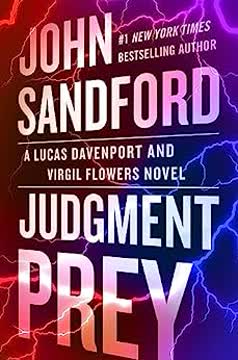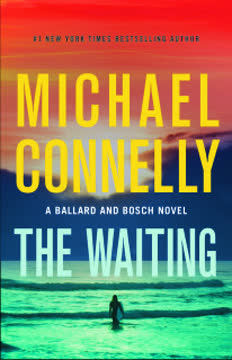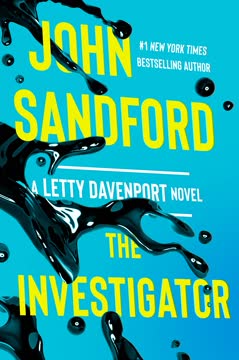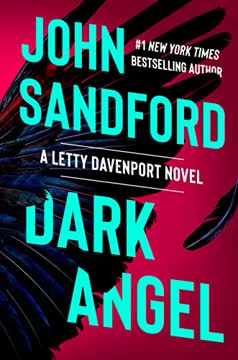Plot Summary
Storm Before the Blood
The novel opens on a stormy autumn night in St. Paul, Minnesota, as federal judge Alex Sand plays basketball with his two sons. The family's warmth and banter are abruptly destroyed when a masked intruder follows them inside and murders Alex and both boys in cold blood, leaving only the infant daughter alive. The killer's methodical violence and the chilling aftermath set the tone for a story about trauma, vengeance, and the search for justice.
The Sand Family Massacre
News of the triple homicide spreads quickly, drawing in law enforcement at all levels. The crime scene is gruesome, with evidence suggesting a targeted, not random, attack. The surviving wife, Margaret Cooper, is left devastated, and the city's elite and political class are shaken. The brutality of the crime, especially the killing of children, ensures intense public and media scrutiny, and the pressure to solve the case mounts.
Wounds and Flashbacks
Lucas Davenport, a U.S. Marshal still recovering from a near-fatal shooting, is drawn into the case. He struggles with physical pain and PTSD, reliving his own recent brush with death. His friend and partner, Virgil Flowers, also bears scars from the same incident. Their personal wounds mirror the emotional devastation of the Sand family, and both men are driven by a need to find meaning and closure through their work.
The Investigation Begins
Davenport and Flowers join a task force with local police and the FBI. They examine the crime scene, review security footage, and interview witnesses. The killer's actions—methodical, yet not quite professional—raise questions about motive. Was it revenge, a botched robbery, or something more personal? The investigators quickly realize the case is more complex than it appears, with few immediate leads.
Cooper and Melton's Pact
Margaret Cooper, shattered by loss, leans on her close friend Ann Melton. Their relationship, both emotional and physical, becomes a source of strength and a secret complicating the investigation. As the official inquiry stalls, Cooper and Melton resolve to seek their own justice, using inside information and legal acumen to track the killer. Their grief transforms into a cold, calculated determination for revenge.
The Killer's Shadow
The killer, revealed as Don Hess, a boxing coach with a hidden predatory past, watches Cooper from the shadows. He is careful, blending into the city's underbelly, and haunted by the possibility that Cooper might identify him. His paranoia grows as the investigation closes in, and he contemplates eliminating Cooper to protect himself. The narrative shifts between his perspective and the investigators', heightening the tension.
Theories and Dead Ends
The task force pursues multiple leads: disgruntled ex-convicts sentenced by Sand, financial motives, and possible connections to Sand's wealthy social circle. Each theory is painstakingly explored and mostly discarded. The missing laptops and phones from the Sand house suggest the killer was after something specific, but the trail is cold. The investigation is mired in bureaucracy, egos, and the limitations of forensic evidence.
The Charity Web
Attention turns to Sand's involvement with local charities, especially Home Streets, a housing initiative run by the charismatic but shady Noah Heath. Financial advisor Tom Burston warns of fraud, and the investigators uncover a web of embezzlement, fake charities, and possible motives for murder. The charity's director, Bob Dahl (aka Darrell Hinton), is exposed as a conman, and the possibility of a financial motive for the killings is explored.
The List of Suspects
The investigators compile a list of those who might benefit from Sand's death, including his wife, her lover Melton, and various business associates. Alibis are checked, relationships dissected, and secrets unearthed. The emotional toll on Cooper and Melton is immense, as their private lives are scrutinized. The possibility that Cooper herself is a suspect is considered and ultimately dismissed, but the tension between official and unofficial investigations grows.
The Search for Motive
As the investigation deepens, the team debates possible motives: revenge from a convict, a financial windfall, or a personal vendetta. The missing electronics suggest the killer sought to erase or obtain sensitive information. The focus shifts to those with access to the Sand family, including staff at the boys' school and extracurricular activities. The possibility of a sexual predator emerges, but evidence is elusive.
The Home Streets Hustle
The unraveling of Home Streets exposes Heath and Hinton's long-running scams. As the police close in, Hinton tries to blackmail Heath, who responds with violence, killing Hinton and later his secretary, Doreen Pollard, to cover his tracks. The investigators, aided by forensic evidence and a bit of luck, connect the dots, but legal maneuvering and a botched search warrant threaten to let Heath escape justice.
The Boardroom Betrayal
At a dramatic board meeting, Cooper confronts Heath with evidence of his crimes. Heath snaps, attacking Cooper and slashing her face with broken glass. The assault is both literal and symbolic—a final act of violence from a man whose respectability was always a mask. Cooper survives, but the attack leaves her physically and emotionally scarred, deepening her resolve for retribution.
The Two Psychopaths
The narrative draws a parallel between Heath, the white-collar sociopath, and Hess, the predatory killer. Both are driven by entitlement and a lack of empathy, and both leave a trail of victims. The investigators realize they are dealing with two distinct but equally dangerous men. As Heath's world collapses, Hess becomes increasingly desperate, setting the stage for a final confrontation.
The Boxing Gym Secret
The breakthrough comes when Davenport and Flowers discover the Sand boys attended boxing classes at the Silver Star gym, run by Hess. Interviews with former students and staff reveal Hess's pattern of grooming and abuse. Cooper and Melton, acting on their own suspicions, break into Hess's house and find hidden laptops and flash drives containing child pornography and evidence of Hess's crimes.
The Trap is Set
Cooper and Melton, now certain of Hess's guilt, set a trap for him at Cooper's house. They arm themselves and prepare for a deadly confrontation, determined to kill Hess if he returns. Davenport and Flowers, suspecting Cooper's intentions, stake out the house, hoping to prevent further bloodshed. The tension between official justice and personal vengeance reaches its peak.
The Night Stalker Returns
On a snowy night, Hess attempts to break into Cooper's house. Cooper, armed and ready, confronts him, but is shot in the leg. Davenport and Flowers pursue Hess through the darkness, exchanging gunfire. The chase is chaotic and dangerous, but ends with Hess wounded and captured. The evidence found in his home ensures his conviction for the Sand murders and his other crimes.
The Final Confrontation
With Hess in custody and Heath disgraced, the case is officially closed. Cooper, however, is left unsatisfied. She feels betrayed by the system's refusal to deliver the death penalty and by the investigators' inability to give her the closure she craves. Her relationship with Melton fractures, and she contemplates her future, haunted by loss and rage.
Aftermath and Reckoning
In the aftermath, Cooper watches as Heath escapes prosecution for murder but is ruined socially and financially. She orchestrates a final act of personal justice, visiting Heath and ensuring he faces consequences beyond the law. The novel ends with Cooper, forever changed, contemplating her scars—both visible and invisible—and the limits of justice in a world where evil often hides behind respectability.
Characters
Lucas Davenport
Davenport is a seasoned U.S. Marshal, physically and psychologically scarred from a recent shooting. His drive to solve the Sand murders is fueled by empathy for the victims and his own need for redemption. He is methodical, intuitive, and sometimes abrasive, but his compassion and sense of justice anchor the investigation. Davenport's relationship with his family and his struggle with PTSD add depth to his character, making him both vulnerable and formidable.
Virgil Flowers
Flowers, a BCA agent and novelist, balances Davenport's intensity with humor and a more relaxed approach. He is deeply empathetic, skilled at reading people, and unafraid to challenge authority. Flowers' rural background and creative mind make him an unconventional but effective investigator. His friendship with Davenport is central to the narrative, providing both comic relief and emotional support.
Margaret Cooper
Cooper is the widow of Alex Sand and mother of the murdered boys. Her grief is profound, but it hardens into a cold determination for justice. Intelligent, resourceful, and emotionally complex, Cooper forms a secret alliance with Ann Melton to hunt her family's killer. Her journey from victim to avenger is marked by moral ambiguity, psychological trauma, and a willingness to cross legal and ethical lines.
Ann Melton
Melton is Cooper's close friend, former lover, and legal advisor. She is pragmatic, fiercely protective, and willing to risk everything for Cooper. Melton's legal expertise and emotional support are crucial in the quest for justice, but her involvement also exposes her to danger and moral compromise. Her relationship with Cooper is both a source of strength and a complicating factor in the investigation.
Don Hess
Hess is a boxing coach and serial abuser who hides in plain sight. His charm and authority mask a deep-seated pathology, and his crimes are both sexual and homicidal. Hess's paranoia and cunning make him a formidable adversary, but his lack of empathy and escalating desperation ultimately lead to his downfall. He embodies the theme of evil lurking beneath respectability.
Noah Heath
Heath is the head of Home Streets and a fixture in St. Paul's philanthropic circles. Beneath his polished exterior lies a ruthless embezzler and, eventually, a murderer. Heath's need for status and control drives him to eliminate threats, including his own employees. His unraveling is both public and private, exposing the rot at the heart of the city's elite.
Darrell Hinton (Bob Dahl)
Hinton, posing as Bob Dahl, is Heath's accomplice in charity fraud. When the investigation closes in, he tries to blackmail Heath and is murdered for his trouble. Hinton's fate illustrates the expendability of those caught in the orbit of sociopaths and the dangers of complicity.
Tom Burston
Burston is the Sand family's financial advisor, wary of the Home Streets scam. He provides key insights into the financial motives behind the murder and serves as a moral counterpoint to the corruption around him. His concern for Cooper's well-being and his own struggles with grief add nuance to his character.
Jimmy Russo & Gary Durey
Russo (St. Paul PD) and Durey (BCA) represent the best of local law enforcement: persistent, collaborative, and unafraid to challenge the system. They navigate bureaucratic obstacles and political pressures, working closely with Davenport and Flowers to solve the case. Their professionalism and integrity are essential to the investigation's success.
Weather Karkinnen
Weather, Davenport's wife and a renowned plastic surgeon, provides emotional and medical support to both her husband and Cooper. Her presence grounds Davenport and offers a glimpse of hope and recovery amid the darkness.
Plot Devices
Dual Investigation Structure
The novel employs a dual narrative: the official police investigation and Cooper/Melton's private vendetta. This structure creates tension, as both teams pursue the killer from different angles, sometimes cooperating, sometimes at odds. The interplay between lawful procedure and vigilante action raises questions about the limits of justice and the morality of revenge.
Red Herrings and Misdirection
Sandford uses a series of red herrings—ex-cons, financial motives, charity fraud—to keep readers and investigators guessing. The true motive and identity of the killer are obscured by layers of misdirection, mirroring the complexity of real-world investigations and the difficulty of discerning truth amid chaos.
Psychological Trauma and Transformation
The psychological impact of violence is a recurring theme. Davenport's PTSD, Cooper's rage, and the killer's paranoia all drive the plot. Trauma transforms characters, sometimes for the better, sometimes for the worse, and the novel explores how people respond to loss, fear, and the desire for retribution.
Social Critique and Satire
The novel skewers the hypocrisy of the city's elite, exposing how charity and philanthropy can mask greed and exploitation. The contrast between public virtue and private vice is embodied in characters like Heath, and the narrative satirizes the self-serving nature of power and privilege.
Foreshadowing and Symbolism
The opening storm foreshadows the chaos to come, while physical scars (Davenport's, Cooper's) symbolize deeper wounds. The recurring motif of eyes—seeing, being seen, surveillance—underscores the themes of exposure and hidden evil. The cyclical nature of violence and the difficulty of true closure are woven throughout.
Analysis
Judgment Prey is a masterful blend of police procedural, psychological thriller, and social commentary. At its core, the novel interrogates the nature of justice: Is it the domain of the law, or does true justice sometimes require personal action? Through the parallel investigations of Davenport/Flowers and Cooper/Melton, Sandford explores the limits of institutional justice and the seductive, dangerous allure of revenge. The novel's villains—Hess, the predatory coach, and Heath, the sociopathic philanthropist—embody the banality of evil, hiding monstrous acts behind masks of normalcy and respectability. The story's women, especially Cooper and Melton, are complex, driven by grief but also agency, challenging the traditional roles of victim and avenger. The narrative's structure, with its shifting perspectives and red herrings, mirrors the confusion and uncertainty of real investigations, while its sharp dialogue and dark humor keep the story grounded and human. Ultimately, Judgment Prey is a meditation on trauma, resilience, and the imperfect, often unsatisfying nature of justice in a world where evil is both ordinary and extraordinary.
Last updated:
Review Summary
Judgment Prey receives mixed reviews, with longtime fans generally enjoying the Lucas Davenport and Virgil Flowers team-up. Readers praise the witty banter between characters and Sandford's fluid writing style. However, some criticize the plot as convoluted and lacking depth, particularly regarding character motivations. The ending disappoints some readers, feeling abrupt or unresolved. Despite these criticisms, many fans consider it an entertaining addition to the series, though not ranking among Sandford's best works. Political references in the book polarize some readers.
Lucas Davenport Series
Similar Books
Download PDF
Download EPUB
.epub digital book format is ideal for reading ebooks on phones, tablets, and e-readers.



















